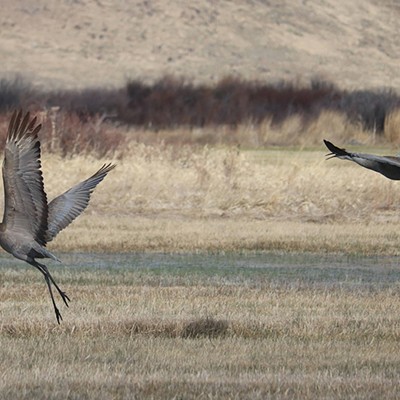I've been getting phone calls and e-mails recently reminding me this is the time of the year when unsuspecting humans meet up with our colorful and common—but sometimes alarming—Jerusalem Cricket.
Of all the insects that live in, under, over and on Central Oregon, none can catch a person's eye and generate more fear, questions, admiration, revulsion and other human emotions like that of Stenopelmatus fuscus, the Jerusalem Cricket, AKA:
· Earth baby· cara de niño (Spanish for "child's face")
· wó see ts'inii (Navajo for "skull insect")
· old bald-headed man
· potato bugs
· skull bug
· What in the $#%# is that!?
They are large (total body length of up to three-inches in length) colorful, flightless insects native to the western United States, and south into Mexico. They come equipped with six large, brightly colored legs, black-and-white striped abdomen, reddish-orange thorax and a reddish head that looks like a human skull.
Early entomologists who were eagerly naming insects wondered where to put them in the zoological order of things. Many of these early bug people thought they looked like king crickets of Australia and the weta of New Zealand, so the name "cricket" stuck. Despite their name(s), however, Jerusalem crickets (Why "Jerusalem?" I haven't the foggiest... ) are neither true crickets nor true bugs and, contrary to one of their names, they do not eat potatoes - whether growing, deep-fried, rotten or frozen.
Incidentally, the New Zealand Maori name for the Giant Weta is "weta punga," a term that is sometimes rendered in English as "god of ugly things." Now, if you can figure out how and why insects normally endemic to Australia are enjoying a happy home here in this part of the North American continent, or visa-versa, you are a better man than I, Gunga Din. Which opens the "what came first, the chicken or the egg?" business. Where did the first of the Stenopelmatus show up in the fossil record, here or there?
The scientific literature says they are "active only at night." (It's dangerous to say "only," as I have seen them out in broad daylight on several occasions). They use their strong mandibles to feed primarily on dead organic material but also eat other insects, dead or alive. Their highly adaptable feet are used for burrowing beneath the soil to feed on decaying roots, plants and dead grasshoppers or gophers someone killed.
Similar to true crickets, each species of Jerusalem cricket produces a different song during mating, but this "song" takes the form of a characteristic drumming in which the insect beats its abdomen against the ground. (This behavior could be similar to that of a frustrated Homo sapian male who beats his fists on the ground, "Not tonight, dear, I have a headache...") Jerusalem crickets apparently rely exclusively on substrate vibrations, which are felt rather than heard.
I received a phone call just the other day from a woman near Sisters who was all excited about a "giant ant" she found under her flagstone walk. I went out to look at it, as I thought it may have been the large and colorful velvet ant, dasymutilla magnifica of Arizona. (Why here? Climate change and all that, you never know...) One look was all I needed to see it was an unfortunate Jerusalem cricket the woman pickled in vodka.
Like some of the Maori, who think of their wetas as "god of ugly things," she too said it was "ugly" and "repulsive." That may account for the number of inaccurate and misleading folk tales regarding Jerusalem crickets.
First and foremost, they are not venomous. They can, however, if handled impolitely, emit a foul smell, and are capable of inflicting a painful bite - but neither is lethal. In spite of their Spanish name, nina de la Tierra, they do not cry like children.
Hoary and Big Brown bats, summertime residents of Central Oregon, prey on Jerusalem Crickets like there's no tomorrow. I'm sure it isn't a mere coincidence that the bats show up just about the time all those sexually inspired crickets head out at night for their annual nighttime escapades.
Most males with sex on their mind aren't the brightest of bulbs, and probably aren't thinking - if capable of thinking at all - they are easy prey for bats. In any event, if you step out to your front porch some morning on the way to work and find a pile of Jerusalem cricket heads and little black piles of bat guano under the roof overhang, you can be sure your home is also a bat's weta restaurant.
Now if some bright science student looking for a free ride to college after reading this takes on some serious studies of the relationships of our Jerusalem crickets and the wetas of New Zealand - that would make my day.



























